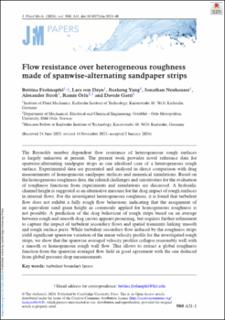| dc.contributor.author | Frohnapfel, B. | |
| dc.contributor.author | von Deyn, L. H. | |
| dc.contributor.author | Yang, J. | |
| dc.contributor.author | Neuhauser, J. | |
| dc.contributor.author | Stroh, A. | |
| dc.contributor.author | Örlü, Ramis | |
| dc.contributor.author | Gatti, D. | |
| dc.date.accessioned | 2024-02-05T09:50:13Z | |
| dc.date.available | 2024-02-05T09:50:13Z | |
| dc.date.created | 2024-02-02T13:59:54Z | |
| dc.date.issued | 2024 | |
| dc.identifier.citation | Journal of Fluid Mechanics. 2024, 980 . | en_US |
| dc.identifier.issn | 0022-1120 | |
| dc.identifier.uri | https://hdl.handle.net/11250/3115507 | |
| dc.description.abstract | The Reynolds number dependent flow resistance of heterogeneous rough surfaces
is largely unknown at present. The present work provides novel reference data for
spanwise-alternating sandpaper strips as one idealised case of a heterogeneous rough
surface. Experimental data are presented and analysed in direct comparison with drag
measurements of homogeneous sandpaper surfaces and numerical simulations. Based on
the homogeneous roughness data, the related challenges and sensitivities for the evaluation
of roughness functions from experiments and simulations are discussed. A hydraulic
channel height is suggested as an alternative measure for the drag impact of rough surfaces
in internal flows. For the investigated heterogeneous roughness, it is found that turbulent
flow does not exhibit a fully rough flow behaviour, indicating that the assignment of
an equivalent sand grain height as commonly applied for homogeneous roughness is
not possible. A prediction of the drag behaviour of rough strips based on an average
between rough and smooth drag curves appears promising, but requires further refinement
to capture the impact of turbulent secondary flows and spatial transients linking smooth
and rough surface parts. While turbulent secondary flow induced by the roughness strips
yield significant spanwise variation of the mean velocity profile for the investigated rough
strips, we show that the spanwise averaged velocity profiles collapse reasonably well with
a smooth or homogeneous rough wall flow. This allows to extract a global roughness
function from the spanwise averaged flow field in good agreement with the one deduced
from global pressure drop measurements. | en_US |
| dc.language.iso | eng | en_US |
| dc.rights | Navngivelse 4.0 Internasjonal | * |
| dc.rights.uri | http://creativecommons.org/licenses/by/4.0/deed.no | * |
| dc.title | Flow resistance over heterogeneous roughness made of spanwise-alternating sandpaper strips | en_US |
| dc.type | Peer reviewed | en_US |
| dc.type | Journal article | en_US |
| dc.description.version | publishedVersion | en_US |
| cristin.ispublished | true | |
| cristin.fulltext | original | |
| cristin.qualitycode | 2 | |
| dc.identifier.doi | 10.1017/jfm.2024.40 | |
| dc.identifier.cristin | 2242622 | |
| dc.source.journal | Journal of Fluid Mechanics | en_US |
| dc.source.volume | 980 | en_US |
| dc.source.pagenumber | 36 | en_US |

